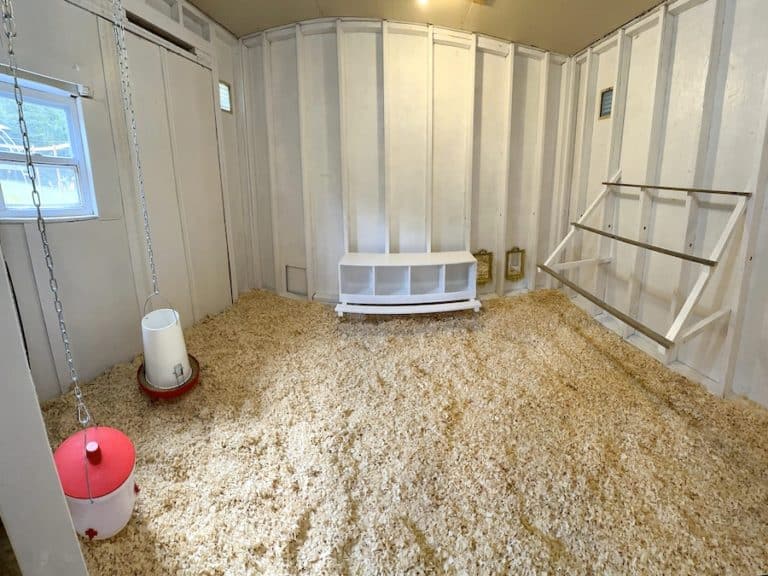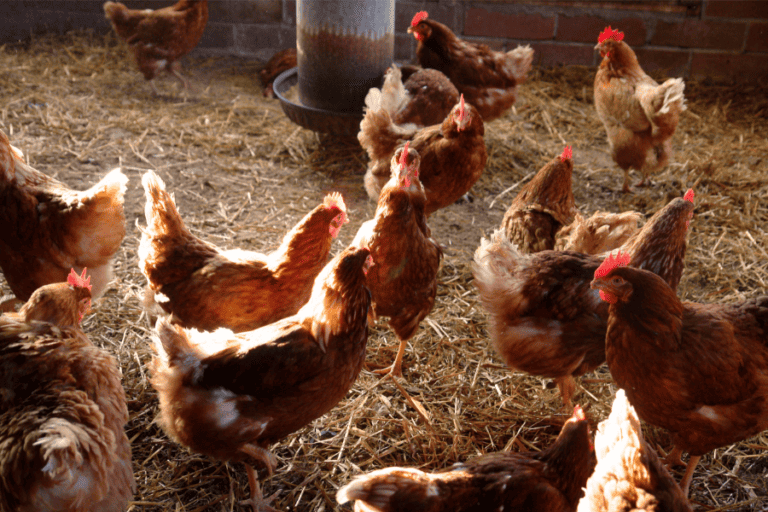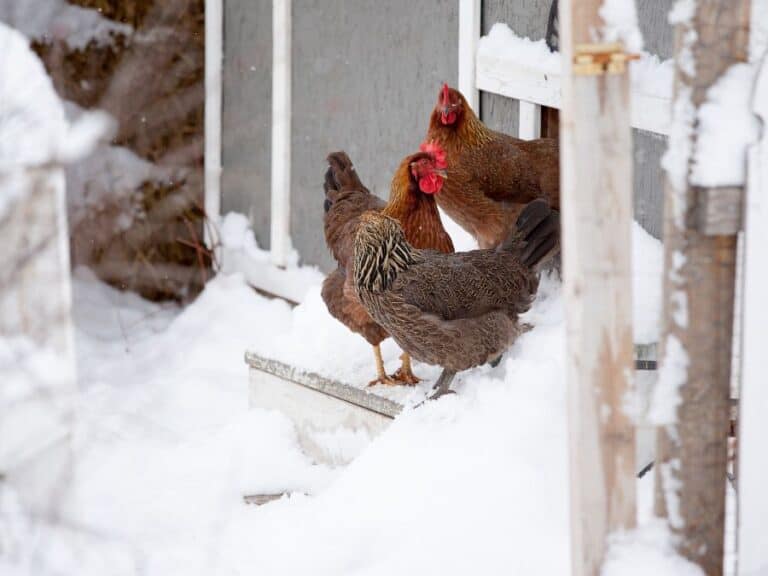7 Ways To Keep Chickens Warm In The Winter

As temperatures drop, keeping your chickens warm becomes a top priority for any homesteader. While chickens are surprisingly resilient to the cold, they still need proper care to stay comfortable, healthy, and productive through winter. The good news? You don’t need expensive heaters or complicated setups to protect your flock from freezing conditions. In this article, we’ll cover seven effective and practical ways to keep your chickens warm, from coop insulation to diet adjustments. Whether you’re new to raising chickens or a seasoned poultry keeper, these tips will help ensure your flock stays cozy all winter long!
Disclaimer: This article includes affiliate links. If you click one of them, we may receive a small percentage of the sale at no extra cost to you. Thank you for your support!
7 Ways To Keep Chickens Warm In The Winter

1. Eliminate All Drafts
Ensuring your chicken coop is draft-free is one of the best ways to keep your chickens warm throughout the winter. While proper ventilation is needed to keep out moisture and ammonia smells and provide clean air, this is different from a draft. A draft typically comes from a crack or opening that allows cold air and moisture to enter the coop. If moisture enters the coop through a draft, it can increase the chances of your chickens getting cold and potentially lead to frostbite.
When looking for drafts, check the entire coop, paying close attention to the doors and windows. If you find any openings or cracks, either caulk, fix or cover them immediately. The sooner you can find them before the winter, the better. On frigid days, you may even consider leaving your chickens inside for the day to avoid too much cold exposure.
2. Insulate The Coop
It is pretty common to insulate a coop over the winter to help keep it warm and reduce drafts. This can be done by adding layers of straw, hemp bedding, pine and wood shavings or other materials to the coop floor. Along with insulating the coop, these materials also help to absorb moisture and prevent bacteria from growing.
Some of you may have heard of this, but the Deep Litter Method is another excellent cost-saving method for insulating your chicken coop. This is sometimes called a built-up litter system and is a form of waste management. Deep Littering is when you allow the chicken’s droppings and bedding to decompose inside the coop all winter, adding new layers of litter every so often on top of the soiled litter rather than replacing it. This will help add extra insulation and provide heat from the decomposition of the litter.
3. Ensure There Is Proper Ventilation
As mentioned above, ventilation is incredibly important for keeping your coop warm, dry and safe for your chickens. Ventilation is meant to help keep the air inside the coop clean by allowing airflow inside. It differs from a draft that lets in more significant amounts of cold air.
Vents should be placed at the top of the coop on opposite sides to create a consistent circulation of air within. You can either install vents, or you can simply drill a few holes near the top of the coop on opposite parallel walls using a hole saw. In the warmer months, windows can be used for ventilation. However, we do not encourage this in the winter months as it can let in too much cold air.
4. Late Night Feeds And Treats
Along with their regular feeding schedule, giving chickens late-night treats in the winter is a great way to help keep their bodies warm throughout the night as their bodies create energy to digest. It is best to go for high-energy foods, as dietary energy is great for maintaining body temperature. Some ideas for late-night snacks to feed your chickens include:
- Chicken scratch (also known as scratch grains)
- Dried cracked corn
- Suet
- Warm oatmeal.
5. Provide A Covered Outdoor Space
Although chickens prefer warmer weather, most chickens are quite hardy and can withstand temperatures below freezing. If you want to provide an outdoor space for your chickens on particularly cold or windy winter days, you can cover the chicken run in a clear plastic tarp. This will let them run around outdoors without freezing and helps to keep snow out of the run.
6. Use A Safe Heating Source
Using a space heater inside a chicken coop is not recommended as it is a fire hazard. Instead, here are a few safe heating sources you can use in your coop to add extra warmth on colder nights.
Hot Water Bottle
This is a great way to keep your chickens cozy and warm without worrying about any potential risks. Simply put hot water into a hot water bottle and wrap it in a towel. Then, place it within the coop so your chickens can cozy onto it. This method may be more work than some of the other heating sources as you will have to regularly change the water in the water bottles to keep them warm.
Heated Pad
A great safe way to provide heat to your coop is by using a chicken coop-safe heated pad such as the K&H Thermo-Chicken Heated Pad. This heating pad can be thermostatically controlled to turn on and off when needed and can be cleaned easily with a damp cloth and mild detergent. If you have electricity running to your chicken coop, this is a superb method that will not require as much maintenance on you as a hot water bulb and is made specifically for chicken coops so they will not run hot enough to be a fire hazard like some of the other heating methods.
A Light Bulb
Lastly, if you have no other choice, you can use a regular 40-watt light bulb to raise the heat a bit within your coop. This is not the best method of heating a coop, but it works if you have electricity running to the coop and do not want to invest in any of the other electric options. If you have a light bulb in your coop, ensure it is secure and not in range of any flammable materials, as it is a fire hazard.
7. Cover Smaller Coops
If the coop is small enough, you can cover it with a blanket or tarp to retain heat during the colder months to help retain heat. Of course, this is a lot harder to do with larger coops. If you have a large coop, try covering the windows at night with a wool blanket (or any other material cloth you might have) to help keep in the heat. Windows can be a big source of heat and energy loss. By covering them, you can significantly reduce the amount of air leakage and heat loss.
Additional Winter Care Tips For Chickens
In addition to keeping the coop warm over the winter, here are some tips for keeping your chickens safe and winter-ready.
1. Do not put a heater in a coop.
While it may seem like a good idea to put a heater in your chicken coop to keep them warm during winter, it is not advised. Placing a heater in the coop can be a potential fire hazard due to the flammable bedding in a confined space. This could not only damage your coop but also harm your chickens. Plus, your chickens do not need a heater. As we learned above, there are numerous other ways to keep your chickens warm that do not involve heaters.
2. Make sure their water does not freeze.
Chickens require access to water daily. It is important over the colder months to frequently check your chicken’s water to ensure it has not frozen, as they cannot peck through the ice. You can do a few things to help reduce the likelihood of their water freezing. The first is to switch from a metal container to a black plastic container for their water. Black objects absorb heat from the sun, while plastic helps retain the heat for longer. This easy and affordable method works great for almost all coops.
If you have electricity in your coop, you may opt for a heated electric waterer or a heated base to warm the waterer. This is an easy way to keep the water from freezing, even in the coldest months. However, there are a few drawbacks.
3. Does Vaseline Protect Chickens From Frostbite?
This is less of a tip and more about breaking a myth. I have seen all over the internet that applying petroleum jelly (Vaseline) on a chicken’s comb can help prevent frostbite. However, this is not the case. Vaseline is not a reliable method to avoid frostbite. Nevertheless, it does have some benefits, such as being great for dry skin and can act as a barrier to moisture. The best way to prevent frostbite is by having a dry and draft-free coop.
Frostbite is most likely to occur on extremely chilly days or nights when there is no sun to warm up the coop and the bedding inside the coop is damp due to poor ventilation or a draft. While frostbite is more common to roosters due to the size of their combs and wattles, it can still happen to chickens. Be sure to keep your chickens hydrated, as dehydration can increase the risk of frostbite.






